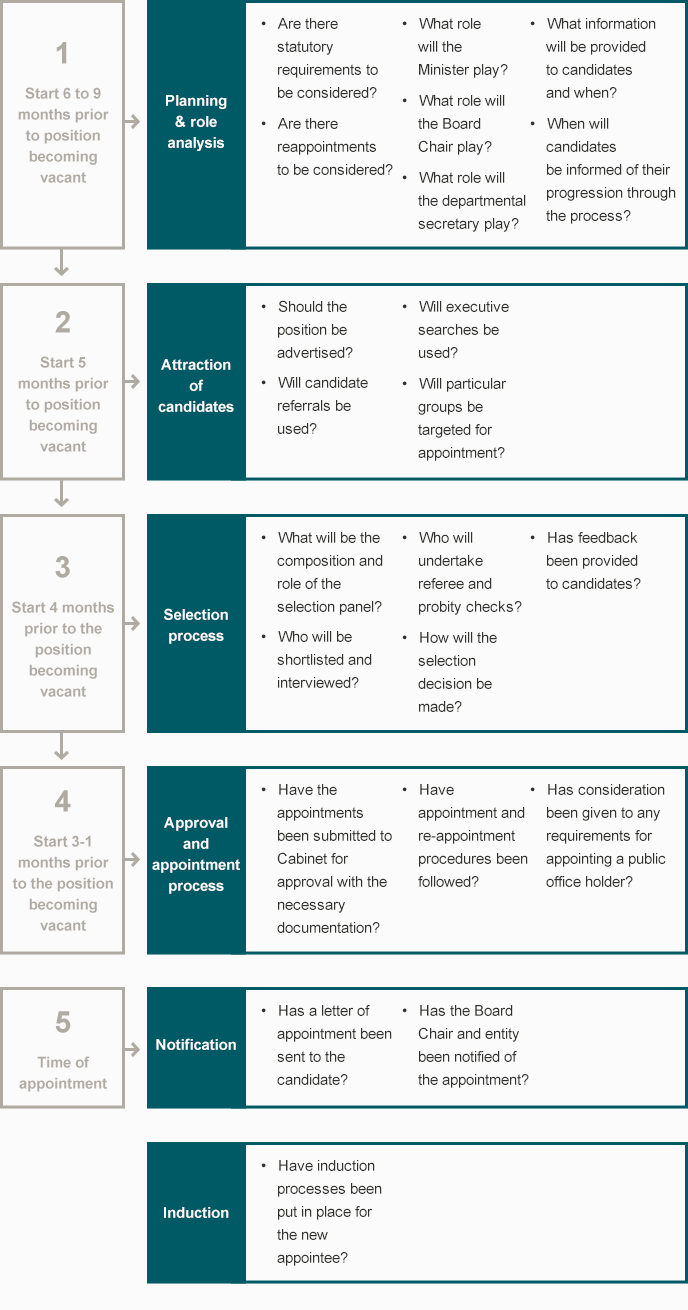Given the timeframes involved, it is important to give due attention to progressively informing candidates as to their status as the process unfolds.
Outlined in Figure 1 is an overview of the indicative process and timelines for recruiting and appointing Directors to public entity Boards. These processes may be amended to fit the diverse circumstances and requirements of public entity Boards.
2.1 Planning and Role Analysis
To attract the best possible candidate(s), thorough planning processes should be undertaken by Boards and departments.
The planning process includes early consideration of the steps in recruitment and selection, scheduling the activity and confirming the involvement of the Minister, Departmental Secretary and Board Chair.
Responsible governance officers should consider developing a recruitment and appointment plan to be agreed by the Minister or the Minister’s delegate and the Departmental Secretary.
Role analysis is critical to recruitment and selection, as it is the foundation of a high quality process. It helps to inform role descriptions and selection criteria.
It is also important for departmental officers to consider the information that should be provided to potential candidates. This enables the candidate to fully understand the role they are applying for, and the time involved in the recruitment and appointment process.
Figure 1: Recruitment and appointment process (with indicative timelines)

2.2 Attraction of Candidates
Advertising positions is a common way of attracting potential Board Directors and helps to ensure a wide audience is reached. It can also help to ensure transparency and accountability in the recruitment process. The use of referrals and executive searches is also considered a legitimate way of sourcing potential candidates. Good practice would suggest the default is advertising. However, there are instances where this is not appropriate, for example, where there are statutory requirements or re-appointments.
Consideration should also be given to how to attract target groups, for example: women, people from rural and regional Victoria, indigenous candidates and/or those from a background to whom the services are principally directed.
2.3 Statutory Requirements
Where an entity is established through legislation, it is important to be clear about any provisions that may affect the process by which a candidate is appointed or is eligible for appointment.
Where the legislation requires nomination from a particular group or organisation, the procedure in the legislation must be followed. In such cases, there is no requirement for advertising or interviewing other candidates and the approval and appointment process can begin.
The legislation may also require Directors to hold particular knowledge and skills; where this occurs the legislation must be followed. In the majority of cases, the Minister has the ability to choose a candidate without reference to any statutory requirements.
2.4 Re-appointments
Board Directors often re-apply and are re-appointed to their Board position after consideration has been given to:
- the Director’s performance during their term on the Board
- whether the personal qualities, character and reputation, knowledge, skills and specialist expertise of the Director are still relevant to the Board
- regular turnover of the Board.
2.5 Selection Process
Due to the key role that public entities play in Victoria in the delivery of government services is it important to have a formalised and structured selection process in place. The selection process involves a number of complex and time consuming steps, including:
- determining the composition and role of the selection panel
- short-listing candidates
- interviewing candidates
- referee checking
- undertaking probity checks on shortlisted candidates
- making a selection decision
- providing feedback to candidates on how they are progressing during the recruitment process.
It is important that these steps are undertaken as expeditiously as possible to ensure candidates have confidence throughout the recruitment and appointment process.
2.6 Approval and Appointment Procedures
There are a number of steps required in seeking approval for the appointment of potential candidate(s), including:
- submitting appointments for approval by Cabinet
- appointment and re-appointment procedures.
Consideration needs to be given to any requirements that might be in place if appointing a public office holder or an individual to multiple Boards.
2.7 Notification and Onboarding
Once a candidate has been appointed it is important that a formal letter of appointment is sent to them advising them of their appointment to the Board.
Induction is often the first contact a Board Director has with their Board or public entity. Having induction procedures in place allows new Directors to participate fully and actively in Board decision-making at the earliest opportunity.
Outlined below is an overview of responsibilities for Ministers, Departmental Secretaries and Board Chairs in the recruitment and appointment process.
